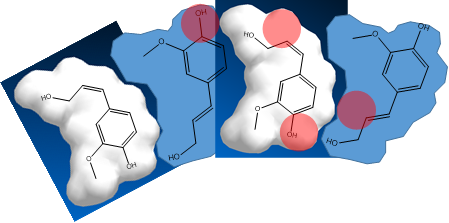Assume a Cylindrical Monolignol
- Kalle Lintinen
- Nov 6, 2023
- 3 min read
My post for the day deals with the agony of striving for perfection but living in a very imperfect world, with imperfect tools and imperfect abilities to use those tools.
During the past days I’ve gradually attempted to depict the double-helical knotting of monolignol toroidosomes. Or more specifically, I’ve avoided it for a couple of days and instead read the book “THE DOUBLE HELIX, A Personal Account of the Discovery of the Structure of DNA.” The book is written by James Watson, the co-discoverer of the DNA double helix. The book depicts the frenzied quest for the structure of the biopolymer that holds the key to life.
While the events took place seventy years ago, it somehow feels very close to home. Though the nucleobase molecules are quite different to monolignols, their main quest was to some extent the same. And in the end, so was their final discovery: two strands of biopolymers hydrogen bonding into a double helix. Of course, in my case the biopolymer forms after the formation of the double helix, but this is the key discovery that I made over three years ago: that monolignols form donut-shaped supramolecular structures.
I already knew the story quite well. I’d seen its TV adaptation, “Life Story”, starring Jeff Goldblum, as a teenager. After my discovery of the toroidosomes I decided to watch it again. Luckily in this time and age, finding the movie was pretty easy. Part of the reason I was procrastinating and not making the model for double-helical alignment was that I knew Blender was acting up, when I tried to align complex shapes along a curve. It really wasn’t a problem with spheres, because they look the same whichever way you rotate them, but with any other shape, they have to be aligned perfectly, or the results are completely off.
Today I decided to try my hand at it and tried to simplify the shape o the monolignol to a flat arc, like this:

but in 3D, where the arrow would be flat. Even this structure is quite off from the actual hydrogen bonded pair that I’d been playing around with previously.

However, even using this simplified structure led to disaster. It wasn’t that I didn’t know what I wanted the molecules to do. The problem was that the structures just turned out wonky, like this:

So, to get anything done, I decided to choose pretty much the simplest structure that could still indicate direction. I chose to represent the pair of monolignols as cylindrical arrow, that I would be aligning into double helices.
And I got this:

While by no means perfect, it for the first time shows that the adjacent helices are rotating in the opposite directions, just like in DNA. If you zoom in a bit, this is quite clear to see:

If I wanted to be lazy, I could try to publish the double-helical lignin hypothesis with just this topological argument and the electron microscope image. The kind of positive thing is that as the ordered structure of the monolignol lattice is disrupted in polymerization, there is no X-ray data that my model must fit. I can leave the exact geometry open.
Perhaps I’ll try to make the images a bit prettier, but I’ll have to see whether I could publish this hypothesis already at this level. There’s of course a lot of experimental work to be done (hopefully by others) after the initial publication, but I think this will be convincing enough.





Comments